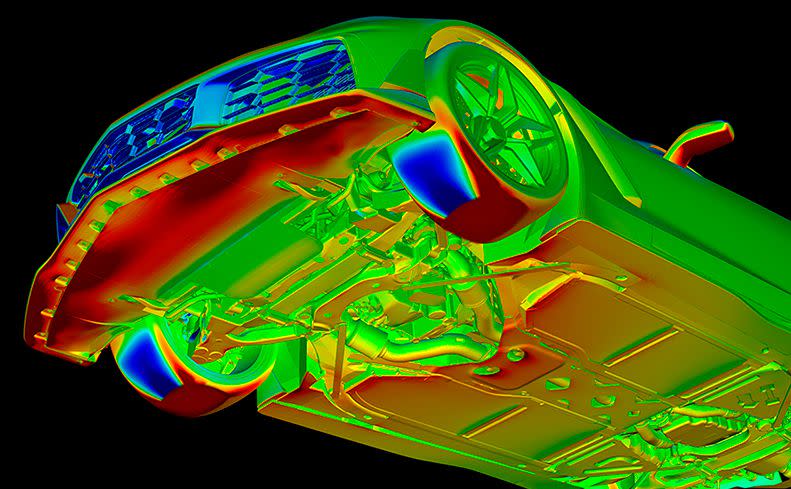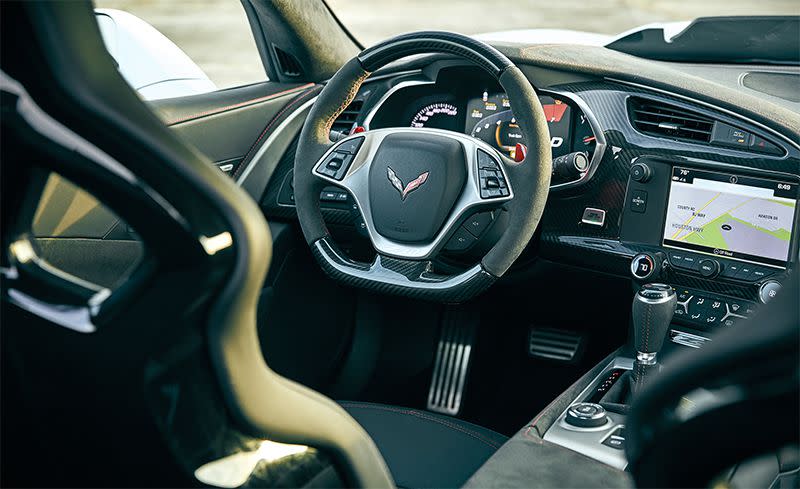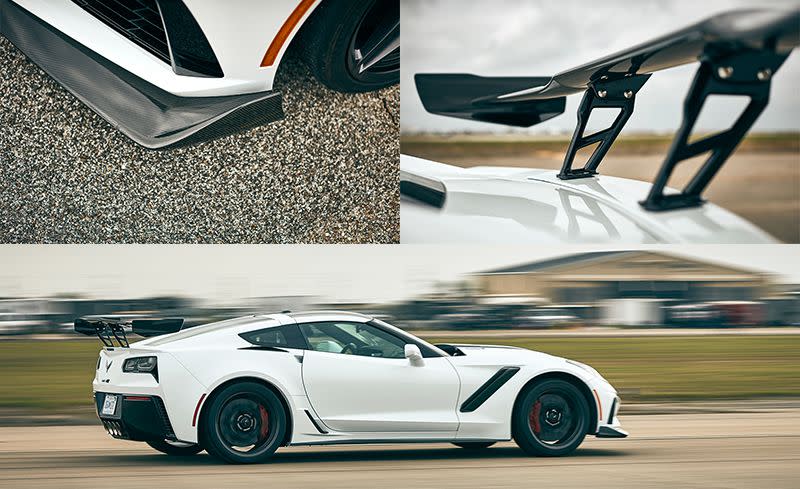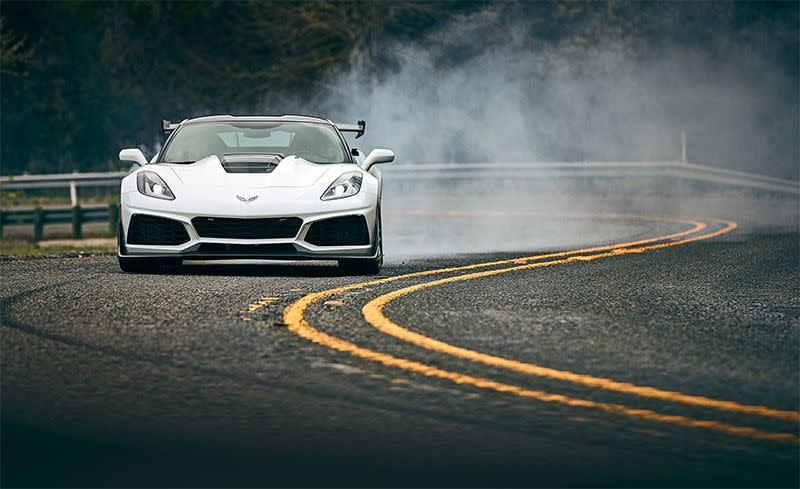This Is a Great Country: The 755-Horsepower Corvette ZR1 Tested

From the June 2018 issue
“Speed kills” is an old trope trotted out by those well-meaning souls who probably haven’t ever actually gone fast. It’s a dictum intended to guilt drivers into socially responsible behavior. We went 183.3 mph in Chevy’s new Corvette ZR1 at the Texas Mile. Not once did we feel guilty.
Truth is, going fast, especially beyond the 150-mph mark, requires you to act responsibly. The activity is fraught with exponentially increasing risk. Accelerating through speeds previously only experienced on the fastest road courses, then keeping the throttle pinned, is particular to the struggle that is the Mile. Started in 2003, the Texas Mile, now held in Victoria, is a standing-mile acceleration test for those seeking a long-term relationship with blurred scenery. Endurance drag racing, if you will. Combining NHRA-like accumulation of speed and dry-lake-bed-like top end for street cars, the Mile is unlike anything else in motorsports, a place to really uncork it.
We didn’t fully grasp this until we were there. Until we saw otherwise unremarkable human beings drive 220 mph in stock-bodied Corvettes. Until we heard all the ZR1’s 755 horsepower erupt from its four howitzer exhaust tips in qualifying. You see, no matter how sober you might be, there are rules at the Texas Mile. And before you’re allowed to give ’er hell the whole way in a car this powerful, you’ve got to show that you can handle it by making a successful qualifying pass between 140 and 165 mph. Somehow, we managed.
Available in either a targa or a convertible body style and fitted with either a high or a low freestanding wing, the ZR1 comes in the shape and aero profile of your choosing. Plant foot to firewall in any version, and its 715-lb-ft ax to the spleen reminds you instantly of the benefits of restraint. The 6.2-liter LT5’s extra power and torque relative to the Z06’s LT4 powerplant largely come courtesy of a supercharger with 52 percent more displacement. The ZR1’s Eaton TVS R2650 blower makes 14.0 psi versus the LT4’s 9.4 and routes it through intercoolers with about double the heat-transfer capacity. Port- and direct-fuel-injection systems combine to meet the additional irrigation needs, and cylinder deactivation goes bye-bye (along with the Eco and Weather drive modes).
We ran the Mile with traction and stability control on but still metered the throttle until second gear arrived. Our car was fitted with the optional eight-speed automatic (a seven-speed manual is standard). Only later, in our own testing, did we discover that 60 mph zaps past in 3.0 seconds and that the ZR1 vaporizes the quarter-mile in 10.8 seconds at 135 mph-both numbers achieved without electronic aids. We also learned that a ZR1 with the $2995 ZTK Track Performance package, as ours was, comes with some very real drawbacks if your only goal is maximizing speed in a standing mile. Included in the package are gummy Michelin Pilot Sport Cup 2 tires, a carbon front splitter with removable end caps, proprietary tuning for the standard magnetorheological dampers, stiffer springs, and, of course, the high wing that most clearly identifies the car as a ZR1. In this configuration, the super-Chevy is a road-course-optimized machine sprouting an abundance of speed-killing, downforce-enhancing appendages. We trimmed the wing to its flattest position (the other option being five degrees of pitch) and prepared to go full pedal the whole way.
The next pass, made on 101-octane race fuel per Chevy’s advice for track use in the ZR1’s owner’s manual, was a 180-mph wake-up call. It was followed by the 183-mph best-effort run. And then we realized the one thing that everyone who drives the Mile eventually realizes: Holding it down is an implacable test of cojones, horsepower, and aerodynamic drag. But it’s that last element that most significantly limits the ZR1 here. Though Chevy couldn’t provide one for this test, the low-wing ZR1 with less drag exists [see “Balancing Drag and Downforce”]. It’s better suited to Texas Mile madness and comes with the fringe benefit of not repelling all females.
There is, however, a reason for the big-wing car: turning stability, something we experienced in the days preceding the Mile in the Texas hill country west of San Antonio. And the ZR1 does, in fact, turn. Like its Stingray Z51, Grand Sport, and Z06 brothers, the Last Samurai of the seventh-generation Corvette uses an electronically controlled rear differential, making it a taloned savage in the hills, a ruthless stalker of apexes, the Overlord of Powerslides. It is also an annihilator of good judgment, catapulting our usual caution into the next county as it encouraged deeper braking and ever higher cornering speeds. It is a GTLM car for the street and exponentially more serious than a standard Stingray. The lighter, more communicative steering of the base car is gone, replaced by a helm as leaden as a tectonic plate. Up against its limits on the skidpad, it lacks the Stingray’s playfulness, replacing it with the heavy-handed pledge of big grip. With its splitter’s side plates installed and its rear wing tipped to the full-downforce position, the ZR1 made 1.18 g’s of grip, virtually identical to the Z06. Its brake pedal proves undeterred by any amount of speed, heat, or momentum. Braking from 183 mph didn’t faze the ZR1’s standard carbon-ceramic rotors any more than did our round of instrumented stops from 70 mph. At 134 feet, the ZR1’s best stop came close but couldn’t match the 128 feet of the 113-pound-lighter Z06.
Our only real complaint concerns the automatic transmission, which lacks the control of most dual-clutch gearboxes or manuals in heated driving. Its response to shift requests is perceptibly delayed, a fact that’s more annoying considering the effectiveness of the manual and its active rev-matching feature.
Comfort compromises are few but undeniable. Though the dampers are retuned to match the heavier front end and higher chassis loads, the 3671-pound ZR1, in Tour mode, offers the same road-trip-friendly compliance we’ve come to expect in every C7. But the ZTK package’s Cup 2 rubber, which has nearly zero void area, screams in protest on some surfaces, resonating with enough noise at 70 mph to be fatiguing on long drives. The less aggressive, and presumably less noisy, Pilot Super Sports come only on the low-wing car. So pick your compromises carefully. Inside, our $141,190 test car included the $1995 Competition Sport seats and plenty of carbon fiber, synthetic suede, and red stitching. It’s a nice place to be and would be more so if it didn’t smell like petrochemicals every time we opened the door on a warm Texas afternoon. Nonetheless, the ZR1 is a miracle of speed-and not just the straight-ahead sort. It effectively answers the question of what the ultimate incarnation of a front-engine Corvette is like.
Two forever memories remain from the Texas Mile. The first is of feeling the ZR1 at speed, testing the pitiless truth of physics and winning. And the second, the one that justifies the whole endeavor, came in the quiet pause after we finally lifted off the big pedal. It’s in that moment, before the result was revealed, that we realized why people do this. Because underneath all the layers of Nomex and despite every nerve in our bodies saying we shouldn’t, every last one of us has a desire to go real damned fast. It’s why we hold it down.
Competitors

Explained: Balancing Drag and Downforce
The goal of the ZR1’s most aggressive aero setup, which is included in the ZTK Track Performance package, is to replicate the aerodynamic characteristics of the Stage 3–equipped Z06 at top speed but to do so more efficiently and with the increased cooling airflow needed to accommodate the LT5’s additional power. The Corvette team exceeded that goal.
“Until now, the Corvette was limited to LT4 power levels by the available airflow,” says Alex MacDonald, vehicle performance manager for Corvette and Camaro. Accordingly, the team needed to boost the cooling flow by widening the nose to increase the intake area, which also increased drag. But maintaining the Z06’s downforce and drag characteristics meant making other crucial changes, such as adding the free-standing rear wing. The switch from the Stage 3 Z06’s body-mounted spoiler to a stand-alone wing reduced drag created by the device while still producing more downforce. The net gain for the big-wing ZR1 is a drag coefficient marginally lower than the Stage 3 Z06’s, 25 to 30 percent more downforce, and 40 percent more cooling airflow.
The small-wing ZR1 sees similar efficiency gains at top speed. Its front splitter looks identical to that of the big-wing ZR1, but it’s what you can’t see that matters. Unlike the Z06’s splitter, the ZTK’s doesn’t just divide air above and below the car; it has a downforce-enhancing airfoil underneath it, which also directs air into the engine compartment and out the duct on the hood. On the small-wing car, that airfoil is partially blocked, reducing both its drag and downforce. That splitter also lacks the carbon-fiber end caps present on the big-wing car’s. The result is a drag coefficient on the small-wing ZR1 that’s about the same as the Stage 1 Z06’s but with marginal downforce rather than lift.

Vette vs. Vette
In the bizarre and fantastic world of supercars, the cup of horsepower runneth over. Three years ago, when the Z06 hit the road, 650 horsepower was plenty. But time and power march on. We dyno-tested the two most powerful production Corvettes in history to document their power differences and discovered that, yes, in fact, Chevy’s claim of a 105-hp gap between the two is legitimate. Our dyno showed a 103-hp delta at the wheels. Drivetrain losses account for a 9 to 10 percent horsepower reduction between crankshaft and tire tread. Consider it your tax for putting power to the ground.
Because we drove directly from the Texas Mile to the dyno, these numbers are from Corvettes running on 101-octane unleaded race fuel. Our other instrumented testing, as always, was performed on the manufacturer’s recommended fuel, in this case 93-octane pump gas. The stock 2016 Z06, like our ZR1 test car, used the eight-speed auto, and both cars made fourth-gear pulls. The ZR1 doesn’t hit its 687-hp peak until 6500 rpm whereas the Z06 maxes out at 584 horsepower at 5600 rpm and then holds steady over the last 900 revs. Both engines produce a huge mesa of usable torque at relatively low engine speeds, but the ZR1’s tilts ever so slightly upward until 4900 rpm.

You Might Also Like

 Yahoo Finance
Yahoo Finance 





